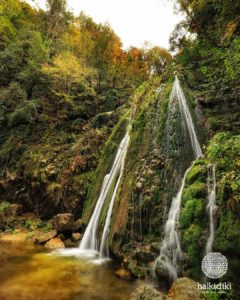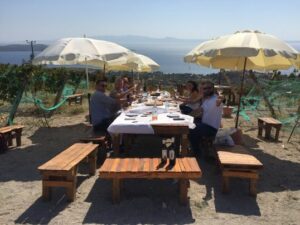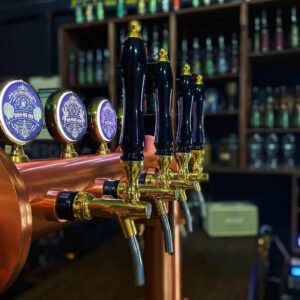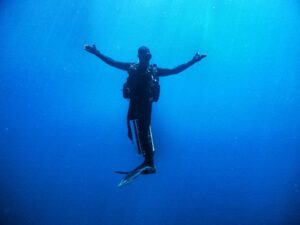From hikes to the fields of Kythera and the olive groves
and the olive groves of Pelion to descents to the forts of Rupel, the
tourism is not only about ancient monuments.
“What hikers are looking for is to chat with people in cafes and
with the people in the cafés and shops, with the farmers in their fields, to see the colours, the flowers, the nature.
Article: Spyros Zonakis
Reportage – Tourism
It is in the late 18th and early 19th century that antiquarianism and Greco-romanticism reach their peak. A trip to Greece conferred prestige and radiance, and no one could deservedly bear the title of traveller unless he had swum in the Euphrates, tasted the olives of Attica and carved the name on the columns of the Parthenon, the Sounion or Delphi.
Nowadays, touring and hiking tourism in our country has been linked rather exclusively to ancient and Byzantine monuments, a disconnection that the people of the , KOINOSEP “Paths of Greece”, founded in 2010.
“We highlight the old paths in a place, we clean them up, we mark them and we promote them. We will make websites with hiking maps, we will make an app where potential hikers can navigate virtually. We plan the trails so that the routes are circular and if possible daily, and so that hikers can get in touch with everything from the Byzantine church and the archaeological site, which is a UNESCO monument, to the most neglected hamlet, the most barren dry rock on a cliff. And also to pass through the heart of every settlement. What hikers are looking for is to talk to people in cafes and shops, to talk to farmers in their fields, to see the colours, the flowers, the nature,” says environmental manager Phoebus Tsaravopoulos, co-founder of the KINSEP. The beginning was with Kythera, where through traversing the paths he discovered incredible treasures, “abandoned villages, stone bridges, waterfalls, forests, which I never imagined existed on this island. 60,000 euros were spent on the creation and operation of the network and this brought the island 1.5 million euros over five years. At the moment we are marking the cycle routes, which cover the whole island, and organising kayaking routes and climbing fields. On the other hand, in Sifnos, we have created routes divided into themes, one with more water, another with ecclesiastical culture, another with antiquities, another with nature, another with crops, and we have implemented a system of certification of hiker-friendly accommodation. In Tinos, we redesigned the entire network of paths, so that to connect all the settlements of the island, we found routes that had been forgotten. And there we made them by theme, e.g. the marble villages, the water and castle road, to the quarries, the geodesic route, the mills’ strata.”
PATHS OF PEACE
Mr Tsaravopoulos is also proud of the Peace Trails in Florina, which are now extended to Kastoria and Kozani. “It is a long, multi-day route. They were so named because they were funded by the Greek-German Future Fund in an area where villages had been burned by the Germans. So we make peace with the past, and with the contrasts of nature, as from the chimneys of Kozani and Ptolemaida, we pass through the wolf and bear sanctuary of Arktouros and wonderful villages such as Nymphaeum, Sklithro, Lehovo and Vlastis, with their robust forests and alpine landscapes.
In recent years, inspiring guides have been planning and offering interactive guided tours on a wide range of themes, from literary, mythological and gastronomic walks ‘to walks on the history of crime in the town’. Undoubtedly, ‘experience tourism’ is here to stay. But it goes hand in hand with ‘slow tourism’. It is difficult to understand a place when you spend less than 12 hours in it,” says Giota Pantou, PhD in archaeology, tour guide and founder of Pelion Culture, which specialises in alternative and thematic tours in Volos and Pelion. Visitors learn about the history of the place through the fruits, trees and mythology. “I start with the olives and olive oil of Pelion. Pelion has three vegetation zones, in the coastal zone we have wonderful olive groves 400 years old and many olive mills scattered in the villages.
Therefore, when we do the guided tour, we visit an olive press in an olive grove, where we talk about the history of olive cultivation, which in our place goes back to the Neolithic times. At the Olympic Games, the prize of the games were panathenaic amphorae full of olive oil, two of which are preserved in the Volos Museum, which we see. They will find out how the olive comes, how it is weighed, how it is washed and then we proceed to a tasting of three or four different kinds of oil. They’ll pick the olives, they will understand how this little flower will become a green olive tree”, stresses Ms Pantou, while the tour continues in the second vegetation zone, “where you can find any kind of fruit tree you want, from apples and quinces to pears, plums, apricots and walnuts. We’re going to visit an agritourism cooperative. Like the one in Vizitsa, where the women in front of us make spoon sweets and jams. We’ll see how they clean them, boil them, skim them, talk to them. At a local farm, they will pick their own fruit and give cooking lessons.
THE KEDDAR
We’ll go even higher, to the third vegetation zone, where we have the herbs. We connect the existence of herbs in Pelion with Centaurus Chiron, who was the first doctor of antiquity and the one who taught all the properties of herbs to Asclepius. We want to introduce our visitors mainly to the mountain tea. Wherever we are, they will taste mountain tea, we will read studies that have been done on this type of tea, which show that it has more antioxidants than green tea, we will talk about how it is made, they will see it in all its forms, in bunches, cut, whole,” he adds.
Aristotle’s Paths is a vision to combine Aristotle’s philosophy of the four elements (water, air, earth, fire) with special cultural and hiking trails in Eastern Halkidiki. “We want to create an experiential experience, so that people can get closer to our heritage, local gastronomy, nature, aromas and give an added value to the tourist product of the region”, explains to “Raftia” the founder of Aristotle’s Paths Polytimi Markogiannaki. “Through a walk in ancient Acanthus, we will see wine, Acanthus wine, as an economic and social link that connects us throughout the centuries. It was the basic export product of the region and this is depicted on a 6th century BC coin, showing a bull and a lion fighting over a vine leaf.
THE FLAVOUR OF IT
MUST
We then walk to the Museum of Necropolis, which is the ancient cemetery in Ierissos, and end up for a wine tasting in a winery, where we will smell the must and learn about the whole wine production process. We will also taste five beer labels at a local brewery, the only one in Halkidiki, where we will also have an interactive seminar on how beer is made and smell the hops in different versions and colors.
In Arnea, we will visit two museums of weaving and the folklore museum. There was a long tradition of weaving in the region. They will learn about the craft unit that exported textiles to the Balkans and while we walk to the Byzantine castle of Paleochori, I will tell them the legend about the castle’s royal queen, who produced gold weavings on a gold loom. Our central idea is to work with local producers and companies that have a positive ecological or social impact in our region,” she says, while, in Arnea, the tourers will end up at an ecological business, “where there is a small museum of beekeeping art and they are informed about how it was done how honey was produced at the beginning of the 20th century and at the same time they taste the muntovina. And in Tripiti, we will dive into the only underwater cellar in Halkidiki, which is combined with wine tasting. While we will also go hiking to the waterfalls of Varvara, where we will then visit the local women’s agricultural cooperative, Driades. We will taste spoon sweets and liqueurs and, when the ladies make trachana, we will also participate in an experiential game of spreading it.”
Verdun is designated as a “Monument City”, making it a world reference point for historical and commemorative tourism. The city is thriving, making the most of the ‘legacy’ left behind by the First World War (one of the most decisive battles of the war was fought there between the French and Germans). “In Verdun, the municipality and the region are implementing plans to develop historical tourism. With one ticket, you can visit everything from forts, battlefields, mausoleums, cemeteries and museums on organised routes, even renting a bicycle. Living in a region with such a rich historical load, we thought we should follow this successful example,” explains journalist Panagiotis Savvidis, vice president of the Agistro Action SOCIOP, which was created in 2016 with headquarters in Agistro Serres and is the first alternative tourism office in Serres.
It is the first alternative tourism in Greece that carries out activities in WWII battlefields and abandoned fortifications.
SUBSIDIES
REVIEWS
“These include tours of the battlefields, the underground forts and the surface works of the Metaxa Line forts. The activities take place at the Rupel Strait, in the northern part of the Serres prefecture, and can be combined with either hiking or cycling. People want to experience something different and not go to a war museum where they will just see two dolls and three guns. We enter the underground forts with period lanterns and the visitor feels like they are experiencing the events, the German invasion. We have both sound and lighting effects so that, depending on the area of the fort where we are, the visitor hears the corresponding narrative and, at the same time, understands what the structure of a complex is like.
Imagine a huge underground camp, including gunner’s corridors, galleys, ammunition stores, staircases leading to the outer machine guns, anti-aircraft observation posts. We are talking about the largest technical project in Greece in the 20th century, 21 complexes from Beles to Rodopi, completed in four years. There is a tremendous increase in the number of visitors to the region,” said Savvidis, during which the organization of a network next to the border with Bulgaria, which would include battlefields of World War II, fortifications of the “Metaxas Line”, local museums, would significantly help the development of small villages, “which today are slowly fading, forgotten, at the same time that most of the forts stand looted and abandoned. They could, in the context of realistic planning, form the basis for the creation of small historical theme parks, organised and signposted trails, which would create new jobs. But we can’t go to that stage, because the Department of Defense is claiming that these areas are still military, which they are indeed under metaxic laws, but it’s kind of an oxymoron to consider them as such, when there is no military in the area at all. A memorandum of understanding on historical, military tourism has been signed three years ago between the Ministries of National Defence, Culture and Tourism, but it has not come into force because the relevant EIA has not been signed,” he informs us.
How would you like fishing tours in the Saronic Gulf, where tourists eat on board the fish they have just caught together with the professional fisherman? And yet, such such excursions are implemented by the fisherman Tasos Ladas in Poros (Poros Fishing Trips).
WITH A FISH
TO BOURTZI
“Fishing trips were made possible in 2015, when the relevant bill was passed. Any coastal fisherman who has a boat from two to 15 meters can engage in fishing tourism, which means he can take tourists and give them a tour, fishing, eating the catch of the day on board. With a maximum of 12 passengers, so there is no competition with the tourist boats. We will start in the morning around nine o’clock, we will raise the nets so they can experience the experience of hauling the nets.
During the fishing trip, we pass by the island of Bourji, I stop to let them see it, to take their pictures. I tell them the history of the island, what is this castle, who built it, what was its use, then we will see some rare species of birds, I explain what kind of birds they are. On a small island, Modi, there is an ancient city and an ancient shipwreck, I will tell them about its history, where the excavations are located, what moves have been made by the archaeological service. After fishing, We will camp in a creek, where we will clean the fish we have collected and prepare our meal. The products we consume are always local, we will not take packaged branded products. Within a few hours, we become friends, as if we had known each other for years, because we also discuss personal things during the trip. They are interested in hearing about your life, learning what the life of a fisherman is like, and they open up about their own lives,” says Mr Ladas, who is satisfied that he is making a small contribution to the protection of the fish stock. “In the months that I am involved in fishing tourism, the quantities of fish I catch are small. If half of the fishermen in Poros were engaged in fishing tourism, the region would take a breather in terms of protecting the local fish stocks. On the other hand, it was also a lifeline economically. Because of overfishing and recreational fishing, which has taken a very large share of the market through the illegal sale of fish, it is very difficult for fishermen to survive on fishing alone,” he concludes.
Source: Shedia







beer tasting, Experiential Tourism, Fishing Trip, Gastronomy, Halkidiki experiences, Halkidiki tours, honey tasting, Luxurious travel Halkidiki, Scuba diving, Scuba diving Halkidiki, Storytelling, Sustainable Tourism, Things to do in Halkidiki, Tourism, Travel, underwater wine cellar, Wine tasting



